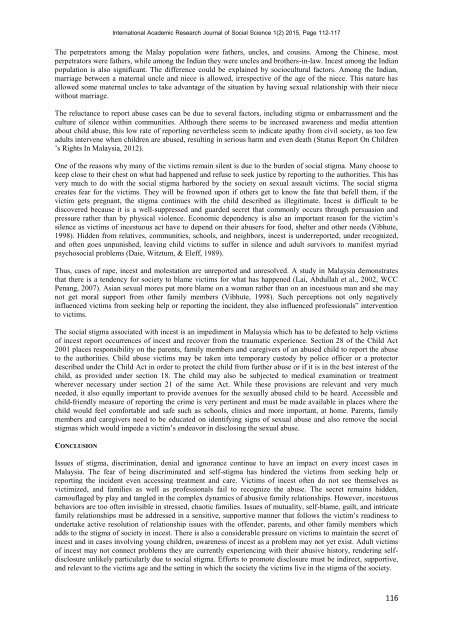Social Stigma of Incest in Malaysia
17-P112-117
17-P112-117
Create successful ePaper yourself
Turn your PDF publications into a flip-book with our unique Google optimized e-Paper software.
International Academic Research Journal <strong>of</strong> <strong>Social</strong> Science 1(2) 2015, Page 112-117<br />
The perpetrators among the Malay population were fathers, uncles, and cous<strong>in</strong>s. Among the Ch<strong>in</strong>ese, most<br />
perpetrators were fathers, while among the Indian they were uncles and brothers-<strong>in</strong>-law. <strong>Incest</strong> among the Indian<br />
population is also significant. The difference could be expla<strong>in</strong>ed by sociocultural factors. Among the Indian,<br />
marriage between a maternal uncle and niece is allowed, irrespective <strong>of</strong> the age <strong>of</strong> the niece. This nature has<br />
allowed some maternal uncles to take advantage <strong>of</strong> the situation by hav<strong>in</strong>g sexual relationship with their niece<br />
without marriage.<br />
The reluctance to report abuse cases can be due to several factors, <strong>in</strong>clud<strong>in</strong>g stigma or embarrassment and the<br />
culture <strong>of</strong> silence with<strong>in</strong> communities. Although there seems to be <strong>in</strong>creased awareness and media attention<br />
about child abuse, this low rate <strong>of</strong> report<strong>in</strong>g nevertheless seem to <strong>in</strong>dicate apathy from civil society, as too few<br />
adults <strong>in</strong>tervene when children are abused, result<strong>in</strong>g <strong>in</strong> serious harm and even death (Status Report On Children<br />
’s Rights In <strong>Malaysia</strong>, 2012).<br />
One <strong>of</strong> the reasons why many <strong>of</strong> the victims rema<strong>in</strong> silent is due to the burden <strong>of</strong> social stigma. Many choose to<br />
keep close to their chest on what had happened and refuse to seek justice by report<strong>in</strong>g to the authorities. This has<br />
very much to do with the social stigma harbored by the society on sexual assault victims. The social stigma<br />
creates fear for the victims. They will be frowned upon if others get to know the fate that befell them, if the<br />
victim gets pregnant, the stigma cont<strong>in</strong>ues with the child described as illegitimate. <strong>Incest</strong> is difficult to be<br />
discovered because it is a well-suppressed and guarded secret that commonly occurs through persuasion and<br />
pressure rather than by physical violence. Economic dependency is also an important reason for the victim’s<br />
silence as victims <strong>of</strong> <strong>in</strong>cestuous act have to depend on their abusers for food, shelter and other needs (Vibhute,<br />
1998). Hidden from relatives, communities, schools, and neighbors, <strong>in</strong>cest is underreported, under recognized,<br />
and <strong>of</strong>ten goes unpunished, leav<strong>in</strong>g child victims to suffer <strong>in</strong> silence and adult survivors to manifest myriad<br />
psychosocial problems (Daie, Witztum, & Eleff, 1989).<br />
Thus, cases <strong>of</strong> rape, <strong>in</strong>cest and molestation are unreported and unresolved. A study <strong>in</strong> <strong>Malaysia</strong> demonstrates<br />
that there is a tendency for society to blame victims for what has happened (Lai, Abdullah et al., 2002, WCC<br />
Penang, 2007). Asian sexual mores put more blame on a woman rather than on an <strong>in</strong>cestuous man and she may<br />
not get moral support from other family members (Vibhute, 1998). Such perceptions not only negatively<br />
<strong>in</strong>fluenced victims from seek<strong>in</strong>g help or report<strong>in</strong>g the <strong>in</strong>cident, they also <strong>in</strong>fluenced pr<strong>of</strong>essionals‟ <strong>in</strong>tervention<br />
to victims.<br />
The social stigma associated with <strong>in</strong>cest is an impediment <strong>in</strong> <strong>Malaysia</strong> which has to be defeated to help victims<br />
<strong>of</strong> <strong>in</strong>cest report occurrences <strong>of</strong> <strong>in</strong>cest and recover from the traumatic experience. Section 28 <strong>of</strong> the Child Act<br />
2001 places responsibility on the parents, family members and caregivers <strong>of</strong> an abused child to report the abuse<br />
to the authorities. Child abuse victims may be taken <strong>in</strong>to temporary custody by police <strong>of</strong>ficer or a protector<br />
described under the Child Act <strong>in</strong> order to protect the child from further abuse or if it is <strong>in</strong> the best <strong>in</strong>terest <strong>of</strong> the<br />
child, as provided under section 18. The child may also be subjected to medical exam<strong>in</strong>ation or treatment<br />
wherever necessary under section 21 <strong>of</strong> the same Act. While these provisions are relevant and very much<br />
needed, it also equally important to provide avenues for the sexually abused child to be heard. Accessible and<br />
child-friendly measure <strong>of</strong> report<strong>in</strong>g the crime is very pert<strong>in</strong>ent and must be made available <strong>in</strong> places where the<br />
child would feel comfortable and safe such as schools, cl<strong>in</strong>ics and more important, at home. Parents, family<br />
members and caregivers need to be educated on identify<strong>in</strong>g signs <strong>of</strong> sexual abuse and also remove the social<br />
stigmas which would impede a victim’s endeavor <strong>in</strong> disclos<strong>in</strong>g the sexual abuse.<br />
CONCLUSION<br />
Issues <strong>of</strong> stigma, discrim<strong>in</strong>ation, denial and ignorance cont<strong>in</strong>ue to have an impact on every <strong>in</strong>cest cases <strong>in</strong><br />
<strong>Malaysia</strong>. The fear <strong>of</strong> be<strong>in</strong>g discrim<strong>in</strong>ated and self-stigma has h<strong>in</strong>dered the victims from seek<strong>in</strong>g help or<br />
report<strong>in</strong>g the <strong>in</strong>cident even access<strong>in</strong>g treatment and care. Victims <strong>of</strong> <strong>in</strong>cest <strong>of</strong>ten do not see themselves as<br />
victimized, and families as well as pr<strong>of</strong>essionals fail to recognize the abuse. The secret rema<strong>in</strong>s hidden,<br />
camouflaged by play and tangled <strong>in</strong> the complex dynamics <strong>of</strong> abusive family relationships. However, <strong>in</strong>cestuous<br />
behaviors are too <strong>of</strong>ten <strong>in</strong>visible <strong>in</strong> stressed, chaotic families. Issues <strong>of</strong> mutuality, self-blame, guilt, and <strong>in</strong>tricate<br />
family relationships must be addressed <strong>in</strong> a sensitive, supportive manner that follows the victim’s read<strong>in</strong>ess to<br />
undertake active resolution <strong>of</strong> relationship issues with the <strong>of</strong>fender, parents, and other family members which<br />
adds to the stigma <strong>of</strong> society <strong>in</strong> <strong>in</strong>cest. There is also a considerable pressure on victims to ma<strong>in</strong>ta<strong>in</strong> the secret <strong>of</strong><br />
<strong>in</strong>cest and <strong>in</strong> cases <strong>in</strong>volv<strong>in</strong>g young children, awareness <strong>of</strong> <strong>in</strong>cest as a problem may not yet exist. Adult victims<br />
<strong>of</strong> <strong>in</strong>cest may not connect problems they are currently experienc<strong>in</strong>g with their abusive history, render<strong>in</strong>g selfdisclosure<br />
unlikely particularly due to social stigma. Efforts to promote disclosure must be <strong>in</strong>direct, supportive,<br />
and relevant to the victims age and the sett<strong>in</strong>g <strong>in</strong> which the society the victims live <strong>in</strong> the stigma <strong>of</strong> the society.<br />
116


